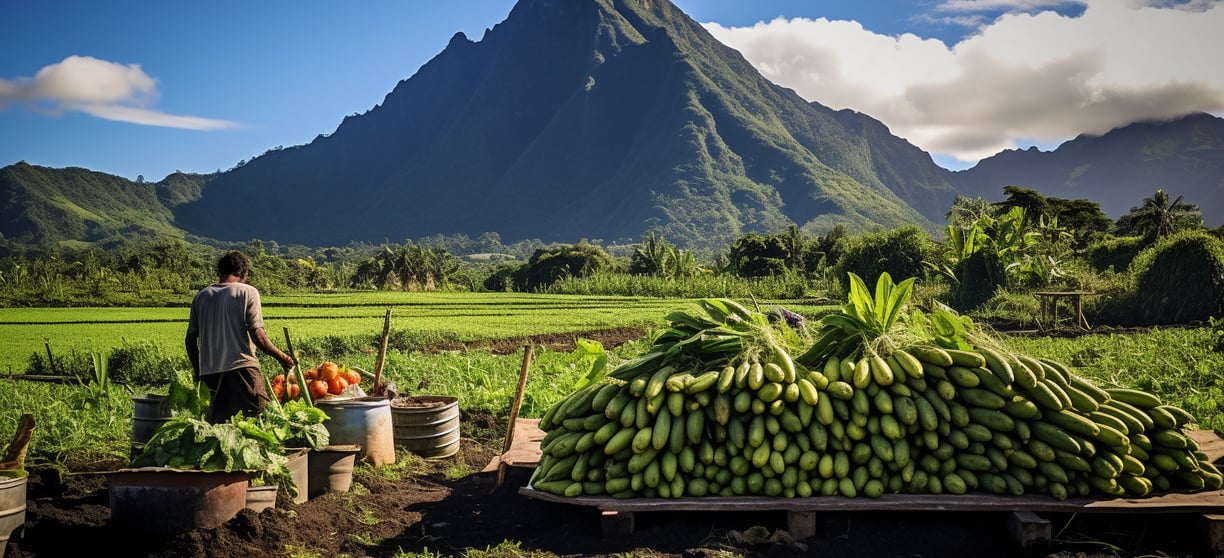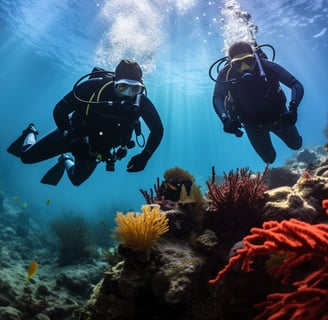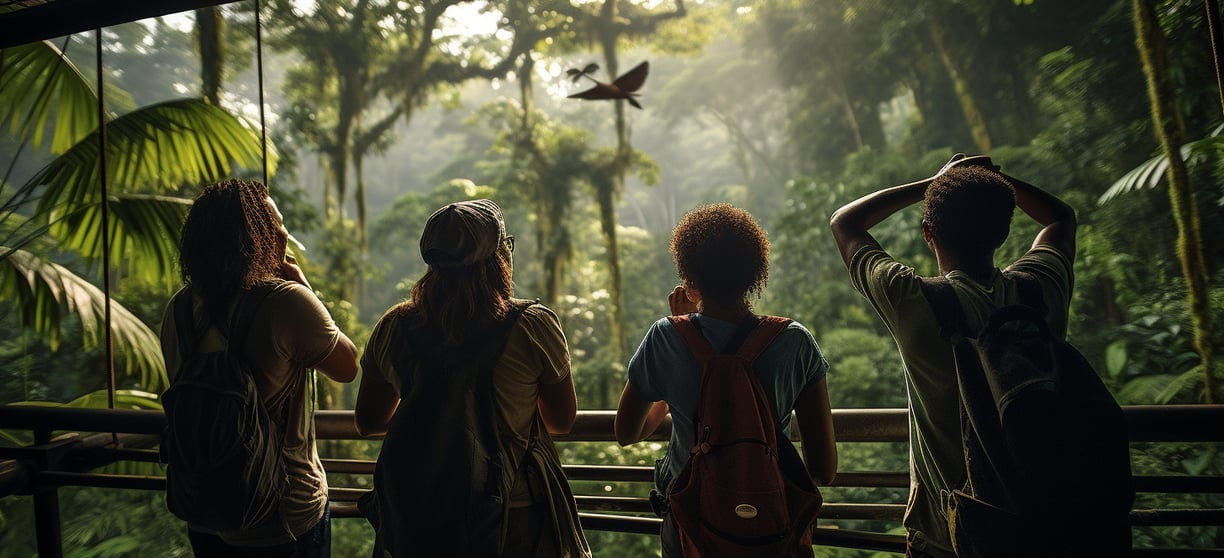Eco-Tourism: The Pacific's Greenest Destinations
Journey through destinations where nature and sustainability dance hand in hand. Discover spots in the Pacific that prioritize our planet, offering eco-conscious travelers memories minus the guilt.


Eco-tourism has gained significant popularity in recent years, with travelers seeking out destinations that prioritize environmental sustainability and conservation efforts. The Pacific region offers some of the world's greenest destinations, providing visitors with unique and immersive experiences while minimizing their impact on the planet. In this article, we will explore the concept of eco-tourism, examine the rise of eco-tourism in the Pacific, highlight the top eco-tourism destinations in the region, discuss sustainable practices in Pacific eco-tourism, and ponder the future of this growing industry.
Understanding Eco-Tourism
Eco-tourism can be defined as responsible travel to natural areas that conserves the environment and improves the well-being of local communities. It involves respecting and protecting the ecosystems, promoting conservation, supporting local economies, and engaging in cultural experiences. Eco-tourism differs from traditional mass tourism by emphasizing sustainability and minimizing negative impacts on the environment and local cultures.
Defining Eco-Tourism
To truly understand eco-tourism, it is essential to recognize its core principles. It promotes environmental awareness, educates visitors about local ecosystems, and encourages active participation in conservation efforts. Furthermore, it contributes to socio-economic development by creating employment opportunities and supporting local businesses.
When engaging in eco-tourism, travelers have the opportunity to immerse themselves in the natural beauty of the destination. They can explore pristine forests, observe rare wildlife species, and marvel at breathtaking landscapes. Through guided tours and educational programs, visitors gain a deeper understanding of the delicate balance of ecosystems and the importance of preserving them for future generations.
Moreover, eco-tourism provides a platform for visitors to actively contribute to conservation efforts. Whether it's participating in habitat restoration projects, volunteering at wildlife sanctuaries, or learning sustainable farming practices from local communities, travelers can make a tangible difference in protecting the environment.
The Importance of Eco-Tourism
Eco-tourism plays a crucial role in promoting the preservation of natural resources and biodiversity. By supporting sustainable initiatives, travelers contribute to habitat protection and the integration of local communities in conservation projects. Additionally, eco-tourism provides economic benefits to communities, reducing the need for environmentally damaging practices such as deforestation or overfishing.
One of the main advantages of eco-tourism is its ability to generate revenue for conservation efforts. The funds generated from eco-tourism activities can be used to establish and maintain protected areas, implement wildlife conservation programs, and support scientific research. This financial support is vital for the long-term sustainability of ecosystems and the preservation of endangered species.
Furthermore, eco-tourism has the potential to create a positive feedback loop. As more travelers engage in eco-tourism, the demand for sustainable practices increases. This, in turn, encourages local communities and businesses to adopt environmentally friendly practices, leading to a more sustainable and resilient tourism industry.
The Impact of Eco-Tourism on Local Communities
One of the key benefits of eco-tourism is its positive impact on local communities. By engaging with local residents, travelers not only gain a deeper understanding of the destination but also help alleviate poverty and promote cultural preservation. Eco-tourism encourages the development of community-based tourism initiatives, highlighting the unique traditions and customs of the local population.
When travelers choose eco-tourism, they actively contribute to the economic development of local communities. By supporting local businesses, such as eco-lodges, organic farms, and artisanal craft cooperatives, travelers help create employment opportunities and stimulate the local economy. This, in turn, reduces the dependence on unsustainable practices and provides alternative livelihoods for communities.
In addition to economic benefits, eco-tourism fosters cultural exchange and understanding. By engaging in cultural experiences, such as traditional dances, cooking classes, or handicraft workshops, travelers gain a deeper appreciation for the rich heritage of the destination. This cultural immersion not only benefits the visitors but also helps preserve and promote local traditions, ensuring their continuity for future generations.
Furthermore, eco-tourism encourages the empowerment of local communities. By involving them in decision-making processes, such as the development of sustainable tourism plans or the establishment of community-managed conservation areas, eco-tourism ensures that the voices and needs of local residents are heard and respected. This participatory approach strengthens the social fabric of communities and promotes a sense of ownership and pride in their natural and cultural heritage.


The Rise of Eco-Tourism in the Pacific
The Pacific region has witnessed a significant increase in eco-tourism in recent years. Several factors have contributed to this rise, including increased environmental awareness, a growing demand for sustainable travel, and the recognition of the region's unique natural assets.
Eco-tourism, also known as sustainable tourism, focuses on minimizing the negative impact on the environment and promoting the conservation of natural resources. It offers travelers the opportunity to explore and appreciate the beauty of the Pacific while supporting local communities and preserving the region's delicate ecosystems.
Historical Overview of Pacific Eco-Tourism
The Pacific has a long-standing tradition of eco-tourism, rooted in the region's rich cultural heritage and commitment to environmental conservation. Countries such as New Zealand, Fiji, and Australia have been at the forefront of sustainable tourism practices, attracting nature enthusiasts and adventure seekers from around the world.
New Zealand, with its breathtaking landscapes and commitment to preserving its unique flora and fauna, has been a pioneer in eco-tourism. The country offers a wide range of eco-friendly activities, such as hiking through national parks, whale watching, and exploring geothermal wonders.
Fiji, known for its pristine beaches and crystal-clear waters, has embraced eco-tourism as a means to protect its fragile coral reefs and marine life. Visitors can participate in coral reef conservation projects, engage in sustainable fishing practices, and learn about the traditional Fijian way of life.
Australia, with its vast and diverse natural wonders, has also played a significant role in promoting eco-tourism in the Pacific. From the Great Barrier Reef to the ancient rainforests of Queensland, the country offers numerous opportunities for travelers to immerse themselves in nature while contributing to its preservation.
Factors Driving Eco-Tourism in the Pacific
Various factors have propelled the growth of eco-tourism in the Pacific. The region's stunning landscapes, diverse ecosystems, and vibrant marine life make it an ideal destination for nature lovers. Travelers can explore lush rainforests, hike up volcanic peaks, or dive into the depths of the Pacific Ocean to witness the incredible biodiversity that exists in this part of the world.
Furthermore, the Pacific's indigenous cultures and their deep connection to the environment create a unique cultural experience for visitors, further enhancing the appeal of eco-tourism in the region. Indigenous communities often play a vital role in eco-tourism initiatives, sharing their traditional knowledge and practices with visitors, and providing insights into their sustainable way of life.
For example, in New Zealand, the Maori people offer cultural tours that not only showcase their rich heritage but also emphasize the importance of preserving the land and its resources. Visitors can learn about traditional Maori practices, such as the concept of kaitiakitanga (guardianship), which promotes the sustainable management of natural resources.
In Fiji, the traditional village of Navala provides a glimpse into the indigenous Fijian way of life. Visitors can participate in activities such as traditional fishing, weaving, and cooking, all while learning about the community's efforts to protect their surrounding environment.
Overall, the rise of eco-tourism in the Pacific can be attributed to a combination of factors, including the region's breathtaking natural beauty, the commitment of local communities to environmental conservation, and the growing demand for sustainable travel options. As more travelers seek meaningful and responsible experiences, the Pacific continues to emerge as a leading destination for eco-tourism, offering a unique blend of adventure, culture, and environmental stewardship.
Top Eco-Tourism Destinations in the Pacific
The Pacific is home to some of the world's most mesmerizing eco-tourism destinations. Let's explore a few notable examples:
Eco-Tourism in New Zealand
New Zealand's pristine landscapes, including fjords, mountains, and national parks, offer endless opportunities for eco-tourism. Visitors can explore the geothermal wonders of Rotorua, hike the famous Milford Track, or embark on a wildlife adventure in the remote subantarctic islands.
One of the most popular eco-tourism activities in New Zealand is exploring the geothermal wonders of Rotorua. This unique region is known for its bubbling mud pools, hot springs, and geysers. Visitors can take guided tours to learn about the geothermal activity and its significance to the Maori culture. The Maori people have a deep spiritual connection to the land and its geothermal features, and they share their knowledge and stories with visitors, providing a rich cultural experience alongside the natural wonders.
The Milford Track is another highlight of eco-tourism in New Zealand. This famous hiking trail takes adventurers through breathtaking landscapes, including snow-capped mountains, pristine lakes, and lush rainforests. Along the way, hikers can spot native bird species, such as the endangered kiwi, and learn about the conservation efforts to protect these unique creatures.
For those seeking a truly remote and untouched eco-tourism experience, the subantarctic islands of New Zealand are a must-visit. These islands are home to a variety of rare and endemic species, including the critically endangered New Zealand sea lion and the yellow-eyed penguin. Travelers can join guided expeditions to observe these incredible creatures in their natural habitats and learn about the conservation efforts being made to protect them.
Eco-Tourism in Fiji
Fiji, known for its turquoise waters and vibrant coral reefs, is a paradise for eco-tourism enthusiasts. Travelers can engage in activities like snorkeling, diving, and wildlife conservation efforts. Additionally, Fiji's eco-lodges provide sustainable accommodation options, often owned and operated by local communities.
When it comes to snorkeling and diving, Fiji offers some of the most diverse and colorful underwater ecosystems in the world. The coral reefs surrounding the islands are teeming with marine life, including tropical fish, sea turtles, and vibrant coral formations. Snorkelers and divers can explore these underwater wonders while being mindful of the importance of preserving these delicate ecosystems. Many eco-tourism operators in Fiji actively participate in coral reef conservation projects, educating visitors about the threats facing these ecosystems and how they can contribute to their protection.
For those interested in wildlife conservation, Fiji provides unique opportunities to get involved. Several organizations and eco-lodges offer volunteer programs where visitors can participate in activities such as sea turtle conservation, mangrove restoration, and sustainable farming practices. These hands-on experiences allow travelers to make a positive impact while learning about Fiji's rich biodiversity and cultural heritage.
Eco-Tourism in Australia
Australia, with its diverse ecosystems and iconic landmarks, attracts eco-tourists from across the globe. The Great Barrier Reef, listed as a UNESCO World Heritage site, offers unparalleled opportunities for snorkeling, diving, and marine conservation activities. The country's national parks, such as the Daintree Rainforest and Kakadu, showcase Australia's unique wildlife and natural wonders.
The Great Barrier Reef is a true natural wonder and a mecca for eco-tourism in Australia. Snorkelers and divers can explore the vibrant coral gardens, swim alongside majestic manta rays, and encounter playful dolphins. However, eco-tourism in the Great Barrier Reef goes beyond recreational activities. Many organizations and research institutions offer educational programs where visitors can learn about the reef's fragile ecosystem, the impacts of climate change, and ongoing conservation efforts. By participating in these programs, travelers can become ambassadors for marine conservation and help protect this global treasure.
Australia's national parks, such as the Daintree Rainforest and Kakadu, provide opportunities for eco-tourists to immerse themselves in the country's unique wildlife and natural landscapes. The Daintree Rainforest, one of the oldest rainforests in the world, is home to a remarkable array of plant and animal species, including the endangered cassowary and the elusive tree kangaroo. Guided walks and eco-tours allow visitors to learn about the rainforest's intricate ecosystems and the importance of preserving this ancient wilderness.
Kakadu National Park, located in the Northern Territory, showcases Australia's diverse landscapes, from rugged escarpments to vast wetlands. This UNESCO World Heritage site is not only a haven for wildlife, including saltwater crocodiles and colorful bird species, but also a place of cultural significance for the Aboriginal people. Visitors can join guided tours led by Indigenous guides, who share their knowledge of the land, its traditional stories, and the ongoing efforts to protect and preserve their cultural heritage.


Sustainable Practices in Pacific Eco-Tourism
Beyond stunning destinations, what sets Pacific eco-tourism apart is the commitment to sustainable practices. Let's explore some of the key initiatives:
Conservation Efforts in Pacific Destinations
Pacific eco-tourism destinations are actively involved in conservation efforts. This includes habitat restoration, wildlife rehabilitation, and biodiversity monitoring programs. By participating in such initiatives, visitors directly contribute to the preservation of fragile ecosystems and endangered species.
Community Involvement in Eco-Tourism
Community-based tourism initiatives are an integral part of Pacific eco-tourism. Local communities actively participate in the design and management of tourism activities. This involvement ensures that the economic benefits of tourism are shared equitably and that cultural heritage is respected and protected.
Future of Eco-Tourism in the Pacific
The future of eco-tourism in the Pacific is promising, with emerging destinations and exciting opportunities on the horizon.
Emerging Eco-Tourism Destinations
Countries like Samoa and Vanuatu are emerging as eco-tourism destinations in the Pacific. Their stunning landscapes, unique cultural experiences, and commitment to sustainability make them ideal for travelers seeking off-the-beaten-path adventures and authentic engagements with local communities.
Challenges and Opportunities for Pacific Eco-Tourism
While the growth of eco-tourism brings numerous benefits, challenges such as climate change, overtourism, and the need for responsible infrastructure development must be addressed. Collaborative efforts by governments, businesses, and travelers are crucial in ensuring the long-term sustainability of eco-tourism in the Pacific.
In conclusion, eco-tourism in the Pacific offers both remarkable experiences for travelers and significant benefits for local communities and the environment. As more people seek sustainable and responsible travel options, the Pacific's greenest destinations are poised to continue thriving. By choosing eco-tourism, travelers not only create unforgettable memories but also become advocates for conservation and positive change. So why wait? Start planning your eco-friendly adventure and become part of the growing movement towards a greener, more sustainable future.


